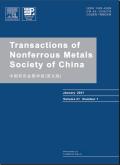Effect of pouring and mold temperatures on fluidity and hot tearing behavior of cast Al−Li−Cu−Mg−Sc−Zr−Ti alloy
IF 4.7
1区 材料科学
Q1 METALLURGY & METALLURGICAL ENGINEERING
Transactions of Nonferrous Metals Society of China
Pub Date : 2025-03-01
DOI:10.1016/S1003-6326(24)66707-5
引用次数: 0
Abstract
The influence of pouring temperature and mold temperature on the fluidity and hot tearing behavior of Al−2Li−2Cu−0.5Mg−0.15Sc−0.1Zr−0.1Ti alloys was investigated by experimental investigation and simulation assessment. The results showed that the length of the spiral fluidity sample increases from 302 to 756 mm as the pouring temperature increases from 680 to 740 °C, and from 293 to 736 mm as the mold temperature increases from 200 to 400 °C. The hot tearing susceptibility (HTS) firstly decreases and then increases with increasing pouring and mold temperatures, which is mainly caused by the oxide inclusion originating from the high activity of Li at excessive pouring temperature. Excessive pouring and mold temperatures easily produce oxide inclusions and holes, leading to a reduction in fluidity and an increase in HTS of the alloy. Combining the experimental and simulation results, the optimized pouring and mold temperatures are ~720 °C and ~300 °C for the cast Al−Li alloy, respectively.
浇注温度和模具温度对铸态Al - Li - Cu - Mg - Sc - Zr - Ti合金流动性和热撕裂行为的影响
通过实验研究和模拟评估,研究了浇注温度和模具温度对Al - 2Li - 2Cu - 0.5Mg - 0.15Sc - 0.1Zr - 0.1Ti合金流动性和热撕裂行为的影响。结果表明:当浇注温度从680℃升高到740℃时,螺旋流体试样的长度从302 mm增加到756 mm;当浇注温度从200℃升高到400℃时,螺旋流体试样的长度从293 mm增加到736 mm;热撕裂敏感性(HTS)随浇注温度和模型温度的升高先降低后升高,这主要是由于过高浇注温度下Li的高活性产生的氧化物夹杂造成的。过高的浇注温度和模具温度容易产生氧化物夹杂物和孔洞,导致合金的流动性降低和高温超导升高。结合实验和模拟结果,铸态Al - Li合金的最佳浇注温度和模具温度分别为~720°C和~300°C。
本文章由计算机程序翻译,如有差异,请以英文原文为准。
求助全文
约1分钟内获得全文
求助全文
来源期刊
CiteScore
7.40
自引率
17.80%
发文量
8456
审稿时长
3.6 months
期刊介绍:
The Transactions of Nonferrous Metals Society of China (Trans. Nonferrous Met. Soc. China), founded in 1991 and sponsored by The Nonferrous Metals Society of China, is published monthly now and mainly contains reports of original research which reflect the new progresses in the field of nonferrous metals science and technology, including mineral processing, extraction metallurgy, metallic materials and heat treatments, metal working, physical metallurgy, powder metallurgy, with the emphasis on fundamental science. It is the unique preeminent publication in English for scientists, engineers, under/post-graduates on the field of nonferrous metals industry. This journal is covered by many famous abstract/index systems and databases such as SCI Expanded, Ei Compendex Plus, INSPEC, CA, METADEX, AJ and JICST.

 求助内容:
求助内容: 应助结果提醒方式:
应助结果提醒方式:


